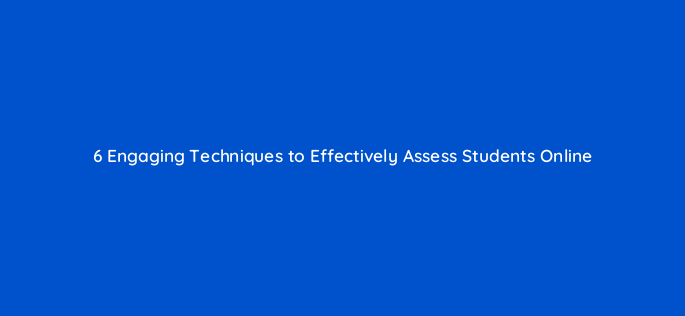Advertisement
Assessment has always been the most challenging and controversial part of the teaching process. The stakes are always high, no matter if the task at hand is giving feedback to preschoolers or marking college students’ essays.
Being fair is such a demanding and even intimidating responsibility. “Being good is easy, what is difficult is being just,” wrote Victor Hugo. It is simple to give everyone a high grade and leave all the doubts and remorse behind you, but it would not do students any good.
To be able to motivate and stimulate the students, the feedback has to be timely, encouraging, and fair. Online assessment allows the teachers to hit all three targets. What is more, well-chosen digital tools turn evaluation into an engaging hands-on experience that effectively supports the students’ learning.
Below, we have reviewed the most rewarding online assessment techniques, which we hope you will find interesting and easy to implement.
Page Contents
Open-Ended Questions and Essays
This tried-and-true paper and pencil method of qualitative assessment works surprisingly well as a form of online evaluation of the students’ higher-level mastery. It is especially effective when the teacher gives students carte blanche in picking the essay format, which can be supplemented by various multimedia materials such as audio recordings, images, videos, etc. Students would love to experiment in the interdisciplinary multimedia space and develop their creative potential alongside their analytical skills.
This method requires more time and effort on the part of the teacher, but it is definitely worth it. Of course, there is always a chance that students will resort to the help of DoMyEssay write my essay for me service, but if the prompt is provocative enough and the format encourages a creative approach, most of them will surely want to try working on this tempting assignment.
Games
Gamification is the ultimate superpower that online assessment can offer teachers all over the world. Educational games empower students to feel more confident and engaged in the learning process, allow them to show off their digital skills as well as their ability to stick to the ‘fair play’ rules, lose with dignity, persevere, and enjoy the well-earned victory.
Such apps as Kahoot! and Socrative can keep learners focused and interested for longer periods.
Quizzes
This time-tested method can be deemed a little old-fashioned, but it is definitely an effective, time-saving, and reliable go-to evaluation technique. It allows checking the comprehensive understanding of the material and its overall interiorization.
Online testing takes a large portion of the workload off the educators’ shoulders and frees their time so that they can engage in more creative and meaningful activities. What is more, the online environment can give it a completely fresh coat of paint. Such helpful apps as Quizalize, EdPuzzle, and Mentimeter can turn the process of testing into a fun pastime equally enjoyed by the students whose motivation and competitive spirit are instantly boosted and teachers who relish the newly-found freedom from tedious, monotonic marking and are still able to closely follow the learners’ progress.
Real-Life Scenarios
This assessment technique is especially effective towards the end of a module or theme when the students have already sharpened their cognitive tools and are eager to test them in the field.
Learners will have a lot of fun participating in mock interviews, conferences, case studies, negotiations, and staff meetings pretending to be top specialists in their chosen area. But they will also need to use every single bit of knowledge they have acquired to live up to their role. This method is extremely rewarding, engaging, and empowering for all the sides involved.
It can be easily implemented with the help of Zoom video conferencing or similar software.
Visuals
Contemporary young people are not likely to be interested in reading a long text which is not spiced up by images. And though this trend can be seen as lamentable, we can try to turn it into an asset.
Asking students to create educational visuals based on the covered material will galvanize their critical thinking skills and encourage them to go over their notes. The motivation to showcase their creativity and digital mastery will bring a sparkle back into their eyes.
The formats suitable for this approach include mind-mapping, infographics, mood boards, and animated videos, but are not limited to them.
Forums and Blogs
“Suddenly online,” a recent survey of undergraduates during the Covid-19 pandemic, has brought into light the issue that troubles most students and is believed to significantly affect the quality of their learning. Having moved to remote instruction, they started to suffer from a serious lack of communication.
Many students say they do not have enough opportunities for collaboration (65%) and no longer feel an integral part of the learning community (50%). Encouraging students to participate in various types of online discussions can help educators tackle this disturbing and yet completely predictable problem.
Moreover, this method offers a wonderful opportunity to engage learners in peer-reviewing activities. Google Docs and Peergrade can assist the teacher in arranging a productive peer evaluation process. Even if some of the students look for essay help online, peer evaluation will keep them engaged in the process of interacting with the relevant material and may prompt them to become more proactive in the virtual discussion.
Conclusion
Each of these methods may prove useful, but they always work best in combination, especially when students are offered a choice and empowered to take ownership of their learning.
Subscribe to our mailing list and get interesting stuff and updates to your email inbox.
